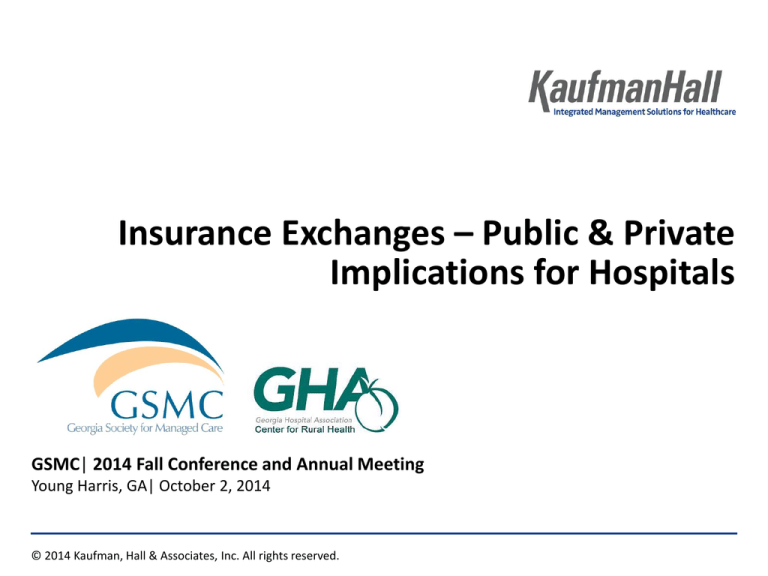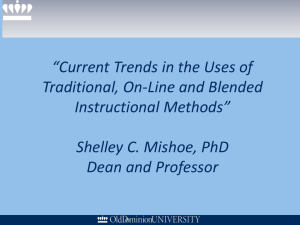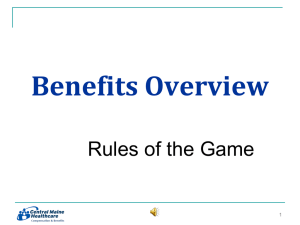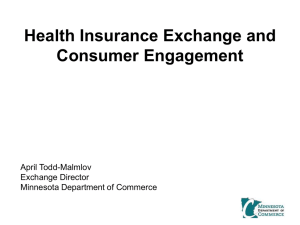
Insurance Exchanges – Public & Private
Implications for Hospitals
GSMC| 2014 Fall Conference and Annual Meeting
Young Harris, GA| October 2, 2014
© 2014 Kaufman, Hall & Associates, Inc. All rights reserved.
Meeting Agenda
• Introductions
• Private exchanges
– What are private exchanges and how do they work?
– Private exchange adoption outlook
– Implications for hospitals and health systems
• Public exchange update
– National
– Georgia
• Narrow network prospects and implications
• Summary implications
• Questions
GSMC 2014 Fall Conference & Annual Meeting
1
Health Insurance Exchanges Are Here
• “Exchanges” are marketplaces for individuals and businesses to
comparison shop and purchase healthcare coverage
• Seek to increase competition and/or consumer choice while providing
benefit standardization, lower costs
• Public and private exchanges will co-exist in many areas
Public: Individual
Private
Public: SHOP
•
Federally mandated for January 2014
•
Won’t exist in all states
•
Individual exchanges will target uninsured and selfinsured individuals
•
Less regulated than
public exchanges
•
SHOP exchanges will target small employers (<50)
early on
•
Will support defined
contribution models
•
Community-rated premiums with limited riskadjustment
•
•
Small business tax credits and individual subsidies
will make exchanges attractive
Various exchange models
will target different
employer segments
GSMC 2014 Fall Conference & Annual Meeting
2
Private Exchanges –
What Are They And How Do They Work?
GSMC 2014 Fall Conference & Annual Meeting
3
Private Exchanges – What Are They?
As the commercial insurance market continues to move from defined benefit to
defined contribution plans, employers will seek new benefit models to
maximize or cap the value of their healthcare benefit subsidies
Private exchanges will support this market shift by offering a broader choice of
plan and coverage options sponsored by a variety of organizations
Private Exchange Sponsors
GSMC 2014 Fall Conference & Annual Meeting
4
Private Exchange Adoption Outlook
GSMC 2014 Fall Conference & Annual Meeting
5
Private Exchange Activity Occurs Across a Range of Employer Sizes
Liazon Forges Partnerships
with National Brokers
Mercer Announces 2014
Private Exchange Participants
Walgreens Joins AON Hewitt
Private Exchange
BAN/USI have 150 US
offices; Liazon exchange
includes 2,000 employers
33 mostly midsize companies
across range of industries will
enroll 75K employees
160K Walgreen’s employees
will enroll in 2014; total AON
2014 enrollment will be 600K
Small to Midsize
Employers
Midsize to Large
Employers
Large
Employers
Note: 600K AON enrollees includes employees and dependents across 18 employers, an increase of 15 employers vs. the 3 employers enrolled in 2013.
Sources: Shutan, B: “BAN Partners with Liazon,” Health Insurance Exchange News, Sept 17, 2013. “USI Helps Clients Manage Employee Benefits Through
Launch of Private Insurance Exchange,” Fort Mill Times, Oct 17, 2013. McCann, D: “Midsize Companies Move to Private Health Exchanges,” CFO.com, Oct
15, 2013. Armstrong D, “Walgreen Joins in Exodus of Workers to Private Exchanges,” Bloomberg, 18 Sept, 2013. “Private Exchanges Woo More Employers,
But Real Traction Won’t Begin Until 2015,” Inside Health Insurance Exchanges, Aug 15, 2013.
GSMC 2014 Fall Conference & Annual Meeting
6
2014 Enrollment Amongst Select Major Private Exchange
Operators Has Reached 1.2 Million Commercial Lives
Exchange
Operator
Total
# of 2014
Enrollees
# of 2014
Employers
# of Enrollees
per Employer
600,000
18
33,333
400,000
14
28,571
100,000
2,400
42
75,000
33
2,273
46,500
3
15,500
1,221,500
2,468
495
Private exchange operators are quickly growing their enrollee bases and appealing
to employers of all sizes
Source: Company press releases and investor conference calls.
GSMC 2014 Fall Conference & Annual Meeting
7
Early Adopters Include Many Household Names with Outsized
Representation by the Retail and Restaurant Industries
GSMC 2014 Fall Conference & Annual Meeting
8
Drivers That Could Impact Commercial Shift to Private Exchanges
Driver
Influence Factors
“Me Too” Effect
Secondary wave of “fast followers” will emerge if initial
wave of employers demonstrates success
Rising Administrative Costs
Employers continue to look for ways to lower
administrative expenses of employee benefits
Delivery Cost
Favorable insurer network contracts will increase plan
participation and pressure on employers to shift
Cadillac Tax
Some employers may use private exchanges to avoid
the excise tax stipulated to begin in 2018
Exchange Plan Options and
Premiums
Plan designs and premiums must be as good or better
than current group coverage
Paternalism
Employers can be paternalistic and resistant to
significant changes in employee benefit design
Union and Public Sector
Collectively bargained cohorts and public sector
employers typically are slower to change
Shift
Impact
↑
↔
↓
Source: “Sizing Up The Healthcare Exchanges - Big Long-Term Opportunity,” Credit Suisse, Sept 26, 2013.
GSMC 2014 Fall Conference & Annual Meeting
9
Implications for Hospitals and Health Systems
GSMC 2014 Fall Conference & Annual Meeting
10
Private Exchanges Are Likely to Lead Some Employees to Trade
Down to Cheaper Options
Impact on Plan Choice of Shift From
Defined Benefit to Defined Contribution
Liazon Corporation1
70%
Primary Options for Employees Seeking
to “Trade Down”
Chose Less
Expensive Plan
“Very few people spend other people’s
money as carefully as they spend their own.”
Milton Friedman
Nobel Prize-Winning Economist
High
Deductible
Narrow/ Tiered
Network
Source: 1. Based on interview with Liazon Corporation (a defined contribution benefit company) documented in Singhal S, Stueland J, and Ungerman D, How
US Health Care Reform Will Affect Employee Benefits. McKinsey & Company, June 2011. 2. Liazon Corporation available at: www.liazon.com.
GSMC 2014 Fall Conference & Annual Meeting
11
Sears and Darden Among the Major Employers to Pioneer the
Private Exchange Concept
Sears and Darden Private Exchange
•
•
•
Sears and Darden chose a defined benefit/ private exchange healthcare benefit model
for 2013
More than 100,000 active employees of Sears, Darden, and other employers were given
a company credit to purchase benefits via an exchange sponsored by Aon Hewitt
Aon Hewitt decision support tools and benefits advisors facilitated employee plan
decisions
Source: 1. Enrollment Results Show Aon Hewitt’s Corporate Exchange Empowers Employees to Become More Astute Health Care Consumers. Aon Hewitt,
March 18, 2013. www.aon.com. 2. Mathews A.W. Big Firms Overhaul Health Coverage. The Wall Street Journal, Sept 26, 2012. online.wsj.com.
GSMC 2014 Fall Conference & Annual Meeting
12
Many Participants Shifted to CDHPs in the First Year of the Sears
and Darden Private Exchange
Distribution of Sears and Darden Employee Health
Benefits by Type of Plan
12%
18%
39%
14%
70%
Consumer-Directed
Health Plan
HMO
PPO
47%
2012
2013
Sears and Darden found that choice of plans changed when employees were
presented with expanded plan options and control over employer subsidy
Source: Mathews A.W. To Save, Workers Take on Health-Cost Risk. The Wall Street Journal, Mar 17 2013. online.wsj.com.
GSMC 2014 Fall Conference & Annual Meeting
13
Transparency Tools Are a Key Catalyst for High Deductible Impact
• Growth in high deductible plans has prompted payers and employers to
develop price transparency tools revealing cost and quality data to members
• Informed patients are likely to choose the “low-cost/high-quality” providers
when faced with increased cost sharing
• Providers in competitive markets are at risk of revenue and market share
erosion as payers and patients become aware of reimbursement variance
• Improving cost structure and competing on value is the only viable
long-term option
Select Companies Offering Transparency Tools
GSMC 2014 Fall Conference & Annual Meeting
14
Private Exchanges Will Break Apart Employee Populations,
Leading to New Contracting and Strategic Considerations
Employee populations
will break apart
Wholesale
Retail
Open
Access
Networks
Narrow/
Tiered
Networks
Lives will be broken up across multiple carriers and networks, many of which could be
narrow or tiered, resulting in increased fragmentation, risk of share and revenue loss
GSMC 2014 Fall Conference & Annual Meeting
15
Exchanges and Value-Based Payments Have Already Merged In
Some Markets
Open Network
ACO Options
Medica Private Exchange
•
Exchange offers MN participants 5 Options (4 with partner ACOs and 1 open network)
•
ACOs seek to lower cost via fee reductions and enhanced coordination/ outcomes
•
More than 40% of enrollees chose ACO plan; all of year-one employers renewed
Source: Anderson J.: Medica Partners with Four Diverse ACOs on Unique Private Exchange Model, ACO Business News, October 2012. Shafer L.: Exchanges
Have Been Tried, and Worked, Star Tribune, October 3, 2013.
GSMC 2014 Fall Conference & Annual Meeting
16
Private Exchanges Will Accelerate the Transition to Emerging
Payment Models and Create New Strategic/ Financial Challenges
Today’s Model
Private Exchanges
Emerging Models
Open Access PPO
High Deductible
Narrow/Tiered
Expected to decline
over time
Likely near-term
model of choice
Expected to increase over time as
narrow/tiered networks mature
Implications
Risk of Share Loss
Price Pressure
Bad Debt
Use Rate Pressure
Limited Threat
GSMC 2014 Fall Conference & Annual Meeting
Significant Threat
17
Public Exchange Update
GSMC 2014 Fall Conference & Annual Meeting
18
Public Exchange Update and Analysis –
National
GSMC 2014 Fall Conference & Annual Meeting
19
Public Exchange Enrollment Surpassed both Incremental and
Cumulative Administration Targets for March
Cumulative U.S. Public Exchange Enrollment1
Thousands
8,020
Public Exchange
Enrollment
•
National public
exchange enrollment
increased to 8.0M
during the initial
enrollment period
•
Administration 2014
enrollment goal was
7.1M
4,242
3,300
2,153
106
364
Oct
Nov
Dec
Jan
Feb
Mar
% Target 21%
30%
65%
75%
75%
113%
3
2
Notes: (1) HHS definition of enrollment (those who have “selected a plan”) (2) March data includes Special Enrollment Period through 19 April 2014 (3)Percentage
of HHS enrollment target.
Sources: ASPE, Health Insurance Marketplace Enrollment Reports, 13 Nov 2013, 11 Dec 2013, 13 Jan 2014, 12 Feb 2014, 11 Mar 2014, and 1 May 2014. Tavenner
M, Projected Monthly Enrollment Targets for Health Insurance Marketplaces in 2014, 5 Sept 2013.
GSMC 2014 Fall Conference & Annual Meeting
20
The Vast Majority of Those Enrolled Nationally Chose Silver and
Bronze Plans
National Plan Selection by Metal Level
Initial Enrollment Period1
Bronze
Plan Choice Trends
20%
2
Cat. (2%)
2%
Platinum
Silver
5%
9%
65%
•
85% of those enrolled nationally
chose cheaper Bronze or Silver plans
•
Silver plans (eligible for cost-sharing
subsidies) are the most popular and
account for 65% of all enrollment
Gold
Notes: (1) Includes additional special enrollment period activity through 19 April 2014. (2) Catastrophic plan.
Source: ASPE, Health Insurance Marketplace Enrollment Report, 1 May 2014.
GSMC 2014 Fall Conference & Annual Meeting
21
Initial National Public Exchange Enrollment Skews Older Than
Administration Targets
National Exchange Age Distribution
Initial Enrollment Period1
25%
23%
55 - 64
45 - 54
17%
35 - 44
18 - 34
Well below national HHS
18-34 target of 39%
<18
28%
6%
•
•
•
•
National
Enrolling young and healthy people is critical to a stable risk pool
Age 18-34 enrollment lags the 39% administration target
How enrollment compares to health plan expectations will dictate plan profitability
The “3Rs” will mitigate premium changes in the near to medium term
Note: (1) Includes additional special enrollment period activity through 19 April 2014.
Source: ASPE, Health Insurance Marketplace Enrollment Report, 1 May 2014.
GSMC 2014 Fall Conference & Annual Meeting
22
Despite Recent Improvements, the Previously Uninsured
Represent Only About Half of the National Enrollment
% of Public Exchange Enrollment by Uninsured
National Surveys
57%
27%
26%
Feb 4 - Feb 13
McKinsey
April 7 - April 16
McKinsey
11%
Nov 25 - Jan 10
McKinsey
•
•
•
June 19
Kaiser
McKinsey surveys suggest that a majority of those enrolled nationally previously had individual or employer
coverage
Broker/ consultant data from mid-January found that 33% were previously uninsured
Kaiser Family Foundation Survey of small sampling suggests that 57% were previously uninsured
Notes: McKinsey data from 11/25 to 1/10 survey, Feb 4 to Feb 13 survey, and April 7 to April 16 survey; Broker/consultant estimates from 1/17 WSJ article.
Sources: Weaver C and Mathews A, Exchange See Little Progress on Uninsured, WSJ, 17 Jan, 2014; Demko P, 27% of 2014 Individual Market Enrollees Previously
Lacked Coverage, Study Says, Modern Healthcare, March 2014: Hamel L, Rao M, Levitt L, Claxton G, Cox C, Pollitz K, Brodie M, Survey of Non-Group Health
Insurance Enrollees, Kaiser Family Foundation, 19 June, 2014..
GSMC 2014 Fall Conference & Annual Meeting
23
Many of Those Who Have Selected a Plan Have Not Yet Paid Their
Premiums
National Estimated Distribution of Enrollees
by Payment Status
As of August 31, 2014
Premiums
Paid
87%
3%
10%
Premiums Expected
to be Paid
How Many Enrollees
Have Paid Their
Premium?
•
3% of current
enrollees drop their
coverage each
month
•
Slightly more than 7
million enrollees
have paid for their
coverage
•
A haircut should be
applied to reported
enrollment figures to
adjust for these nonpayments
Premiums
Unpaid
Source: The Graph, Updated: Paid QHPs should have broken 8 million at last! ACASignups.net, August 31, 2014, http://obamacaresignups.net/14/08/31/graphupdated-paid-qhps-should-have-broken-8-million-last-92m-total
GSMC 2014 Fall Conference & Annual Meeting
24
Public Exchange Update and Analysis –
Georgia
GSMC 2014 Fall Conference & Annual Meeting
25
Georgia Is One of 28 Federally Facilitated Exchanges
7
17
Source: Kaiser Family Foundation, www.statehealthfacts.org. State Decisions For Creating Health Insurance Exchanges as of Oct. 2013.
GSMC 2014 Fall Conference & Annual Meeting
26
Public Exchange Enrollment in Georgia Surpassed Administration
Targets
Cumulative Georgia Enrollment1
316,543
Public Exchange
Enrollment
•
GA public exchange
enrollment
increased to
316,543
•
Full year HHS target
was 204,000
•
Enrollment in GA
reached 155% of
HHS initial
enrollment target
139,371
101,276
58,611
1,390
6,859
Oct
Nov
Dec
Jan
Feb
Mar
% Target 10%
20%
61%
80%
85%
155%
3
2
Notes: (1) HHS definition of enrollment (those who have “selected a plan”) (2) March data includes Special Enrollment Period through 19 April 2014 (3)Percentage
of HHS enrollment target.
Sources: ASPE, Health Insurance Marketplace Enrollment Reports, 13 Nov 2013, 11 Dec 2013, 13 Jan 2014, 12 Feb 2014, 11 Mar 2014, and 1 May 2014. Tavenner
M, Projected Monthly Enrollment Targets for Health Insurance Marketplaces in 2014, 5 Sept 2013.
GSMC 2014 Fall Conference & Annual Meeting
27
Absolute Level of Public Exchange Enrollment in Georgia
Surpasses National Average
Cumulative Public Exchange Enrollment by State
Absolute Enrollment
California: 1,405,102
400,000
Florida: 983,775
Texas: 733,757
350,000
Federally–Run Exchange
300,000
Georgia: 316,543
State–Run Exchange
250,000
200,000
National Average: 157,250
150,000
100,000
50,000
CA
FL
TX
NY
NC
PA
GA
MI
IL
VA
WA
NJ
OH
MO
TN
WI
IN
CO
AZ
SC
LA
AL
UT
KY
CT
ID
OK
OR
MD
MS
KS
MN
NV
ME
AR
NE
NH
VT
MT
NM
MA
IA
RI
WV
DE
SD
AK
WY
DC
ND
HI
Source: Department of Health and Human Services; Health Insurance Marketplace: Addendum to the Summary Enrollment Report for the Initial Annual Open
Enrollment Period; 1 May 2014
GSMC 2014 Fall Conference & Annual Meeting
28
Georgia Also Surpasses National Averages as a Percentage
of HHS Targets
250%
Cumulative Public Exchange Enrollment by State
% of HHS Targets
Federally–Run Exchange
200%
Georgia: 155%
State–Run Exchange
150%
National Average: 113%
100%
50%
CT
RI
NH
FL
ME
ID
NC
WI
DE
VA
NY
MI
NJ
GA
PA
IL
UT
CO
MO
SC
TN
AL
MT
TX
LA
AZ
CA
KS
NE
MS
IN
ND
HI
WY
AR
WV
OK
OH
MN
IA
SD
VT
AK
WA
MD
NV
NM
KY
OR
DC
MA
0%
Source: Department of Health and Human Services; Health Insurance Marketplace: Addendum to the Summary Enrollment Report for the Initial Annual Open
Enrollment Period; 1 May 2014
GSMC 2014 Fall Conference & Annual Meeting
29
Bronze and Silver Plans Make Up 82% of Public Exchange
Enrollment in Georgia
Plan Selection by Metal Level
Initial Annual Open Enrollment Period1
National
Georgia
Bronze
Bronze
11%
Cat. (2%)
2%2
Platinum 10%
Gold
20%
71%
Silver
Cat. (2%) 2%
Platinum
5%
9%
Silver
65%
7%
Gold
•
Plan selection in Georgia skews toward low cost Silver and Bronze plans but slightly less
so than the national average
Note: (1) Includes additional special enrollment period activity through 19 April 2014. (2) Catastrophic plan
Source: ASPE, Health Insurance Marketplace Enrollment Report, 1 May 2014.
GSMC 2014 Fall Conference & Annual Meeting
30
Age Distribution of Georgia and National Enrollment Are Similar
Exchange Age Distribution
Initial Enrollment Period1
21%
25%
23%
23%
55 – 64
45 – 54
20%
17%
35 – 44
18 – 34
<18
•
•
32%
28%
5%
6%
Georgia
National
Georgia has a slightly lower percentage of enrollees between the ages of 55 and 64
than the national average
32% of Georgia enrollees are in the pivotal 18–34 cohort, which is slightly higher than
the national average (28%) and well below the administration target (39%)
Note: (1) Includes additional special enrollment period activity through 19 April 2014.
Source: ASPE, Health Insurance Marketplace Enrollment Report, 1 May 2014.
GSMC 2014 Fall Conference & Annual Meeting
31
Georgia Bronze Premiums Are Slightly Higher than the
National Average
Monthly Premium of Lowest Cost Individual Bronze Plan in State1
$450
$425
$400
National Avg:
$249
$350
$300
$265
$250
$200
$144
$150
$100
MN
TN
OK
KS
MD
IL
UT
DC
OR
IA
TX
AZ
MI
NM
ID
NV
PA
CO
NE
VA
AL
MO
Avg.
FL
MT
OH
WA
RI
LA
SC
GA
AR
NY
CA
WV
NC
ND
WI
NH
IN
SD
DE
NJ
ME
CT
VT
AK
MS
$0
WY
$50
Note: 1) Age weighting for all states is based on expected age distribution in the Marketplaces, estimated by the RAND Corporation.
Source: APSE Issue Brief, Health Insurance Marketplace Premiums for 2014, Health and Human Services, avail able at: aspe.hhs.gov (accessed Oct 1, 2013).
GSMC 2014 Fall Conference & Annual Meeting
32
Georgia’s Five Individual Market Plans Puts the State Toward the
Middle of the Pack
Insurer Competition by State
Individual Market
Source: Avalere Health, Analysis on Health Plan Offerings on the Federally-Facilitated Marketplace, 3 Oct 2013.
GSMC 2014 Fall Conference & Annual Meeting
33
Georgia Health Insurance Exchange Participants – Blue Cross Blue
Shield of Georgia Plans are Available State Wide
Georgia Public Individual
Exchange Participants
Georgia Public SHOP Exchange
Participants
Source: Miller, A.: UnitedHealthcare to be fourth company to offer insurance in State Exchange next year, The Augusta Chronicle, July 14, 2014
GSMC 2014 Fall Conference & Annual Meeting
34
Drivers That Could Impact Commercial Shift and Employer
“Dumping” to Public Exchanges
Driver
Firm Size
Subsidy/ Tax Credits
Delivery Cost
Wages/ Part-Time
Workforce/ Retirees
Exchange Implementation
and Promotion
Timing
Recruitment and
Retention
Exchange Plan Options
and Premiums
Penalties
Influence Factors
Shift
Impact
Small firms are more likely to choose SHOP exchanges or dump to HIX
Subsidy and tax credit availability will stimulate exchange uptake
Favorable insurer network contracts will increase plan participation
and pressure on employers to shift
↑
Low-wage geographies will have greater subsidy availability; part-time
employees and pre-65 retirees more apt to shift
Good communication, promotion, and receptivity will stimulate
enrollment
Uptake could initially be slow but increase over time once the market
settles out, particularly if the “me too” effect takes hold
↔
Higher skilled/ wage employers who prioritize recruitment and
retention may not be willing to shift to public exchanges
Fewer plan options and higher premiums will delay uptake
↓
Employer responsibility penalties a key deterrent for larger employers;
fear among some that penalties could be increased in the future
GSMC 2014 Fall Conference & Annual Meeting
35
Public Exchange Analysis Summary Observations
• Georgia is one of 28 Federally-Facilitated Exchanges
• Georgia enrollment of 316,543 far exceeded the HHS projection of
204,000
• Of the 50 States, Georgia was ranked 7th in enrollment
• Georgia was one of 24 States that exceeded the HHS enrollment goals
• Leaner and less expensive silver (71%) and bronze (11%) plans are
currently the most popular in Georgia which could result in collection
challenges for providers
• 32% of Georgia enrollees are in the pivotal 18–34 cohort, which is
slightly higher than the national average (28%) and well below the
administration target (39%)
• Average Bronze Premiums were slightly higher than the National
Average
• There was a decent selection of plans available in Georgia
Source: Medicaid & CHIP: April 2014 Monthly Applications, Eligibility Determinations and Enrollment Report, June 4, 2014
GSMC 2014 Fall Conference & Annual Meeting
36
Narrow Network Considerations
GSMC 2014 Fall Conference & Annual Meeting
37
Limited Networks Will Have a Significant Presence on the
Georgia Public Exchange
120%
2014 Limited Network Percentage of Plan Offerings By State
Federal Exchange States
Limited Network
Penetration
100%
•
80%
72%
60%
•
40%
20%
Network adequacy
regulations, hospital
competition, spare
capacity will influence
prevalence
72% of plans offered
on Georgia’s
exchange were
narrow network
plans
NH
SC
IN
NJ
FL
UT
DE
VA
GA
WY
SD
MS
WI
MI
TX
ME
PA
OK
IA
OH
AZ
ND
TN
IL
LA
NC
NE
AK
AL
AR
KS
MO
MT
WV
0%
Note: Limited network defined as EPO and HMO plans. Survey results exclude the 49% of respondents who indicated that they “did not know” their exchange contract network plan design.
Source: Health Insurance Marketplace Premiums for 2014 Databook (Information Current as of Sept 18, 2013); MHA member survey.
GSMC 2014 Fall Conference & Annual Meeting
38
Commercial Market Share by Service Area
Conceptual Illustration
100%
90%
Tot.
Discharges
Tot.
Discharges
25%
36%
Market Share
80%
70%
60%
23%
Tot.
Discharges
65%
18%
50%
Competitor 1
40%
30%
20%
Other Competitors
Client
6%
52%
46%
29%
10%
0%
PSA
SSA
GSMC 2014 Fall Conference & Annual Meeting
PSA + SSA
39
Understanding What Is Truly “in Play” with Narrow Network
Contracts – Emergent vs. Elective Volumes
Conceptual Illustration
Elective vs. Emergent Inpatient Admissions
% of Client Commercial Volume
45%
Elective
55%
Emergency
45% of inpatient commercial volume is emergent and therefore would not
be steered by a narrow network contract
GSMC 2014 Fall Conference & Annual Meeting
40
How Much Capacity Is Available to Make Narrow Network Plays?
Conceptual Illustration
Client Occupancy by Facility
Client Hospital 1
Client Hospital 2
Client Hospital 3
System Total
Staffed Beds
403
254
194
851
Occupancy
85%
73%
45%
68%
• Overall, two of the three hospitals appear to have capacity at current
occupancy rates to accommodate additional incremental elective
volumes
GSMC 2014 Fall Conference & Annual Meeting
41
Key Considerations for Narrow Network Participation
Key Consideration Steps:
1. Evaluate market share of local competitors to quantify if additional
share can be gained
• How much volume is potentially at risk if you do not participate?
2. Based on available market share, evaluate elective vs. emergent split –
how much elective volume can you expect to gain?
3. Does the organization have the capacity to handle the additional
volume?
4. What discounts will be required to participate in narrow networks and
are individuals likely to choose narrow networks?
In pursuing a narrow network contract, is it worth discounting rates to
obtain additional volume, and if so, by how much?
GSMC 2014 Fall Conference & Annual Meeting
42
Summary Implications
GSMC 2014 Fall Conference & Annual Meeting
43
Balancing New Revenue Opportunities and Cannibalizing the
Existing Commercial Business
Uninsured
Exchange
Commercial
Exchange
New Rev.
Lost Rev.
What is the optimal way to balance these threats and opportunities?
GSMC 2014 Fall Conference & Annual Meeting
44
Summary Implications
• Exchanges will catalyze the shift of purchasing healthcare benefits from
the wholesale to the retail channel
• This channel shift will change the behavioral economics of plan
purchasing decisions and increase the prevalence of high deductible
and narrow network plans
• Value-based reimbursement will increase over the long-term as pricing
and cost pressures grow, which will require improved cross-continuum
care coordination
• Competing on value and improving cost structure are the only viable
long-term options for continued growth
GSMC 2014 Fall Conference & Annual Meeting
45
How Do You Prepare for the Increasing Shift to Public and Private
Exchanges?
Kaufman Hall believes that operational and financial success with healthcare
exchanges requires an integrated planning framework
• Strategic Planning: A Health Insurance Exchange Strategy will be necessary to
compete in the changing market environment. New reimbursement and
contract models, in addition to FFS, will be used for exchange-based products,
most likely requiring providers to assess and acquire new strategies and tactics
• Financial Planning: Many health systems and providers are in the early stages or
have not yet begun to plan for how health insurance exchanges will impact their
current and future patient populations and revenue base. A thorough analysis
and plan to quantify the implications and potential financial impact should be
completed
• Tactical Planning: New skills and capabilities will certainly be required for
financial and operational success when working with health insurance
exchanges. Developing the right tactical plan, resources, and investments while
taking into consideration specific opportunities, priorities, risks, and benefits will
be necessary
Exchanges are expanding; make sure your organization is prepared
GSMC 2014 Fall Conference & Annual Meeting
46
Discussion/ Questions
GSMC 2014 Fall Conference & Annual Meeting
47
Kaufman Hall
Services at a Glance
CAPITAL MARKETS
Since 1985, Kaufman Hall
has acted as financial
advisor to more than 1050
healthcare debt transactions.
Total debt and swaps issued
on behalf of our clients
exceeds $105 billion and $50
billion, respectively
COMPREHENSIVE
SOFTWARE SUITE
Over 1,400 software
licenses are in place
nationwide. The ENUFF
Software Suite uses
corporate finance principles
to directly support the
financial management cycle
FINANCIAL AND CAPITAL
PLANNING
Introduced concept of
strategic financial planning to
healthcare field in 1983.
Kaufman Hall has prepared
financial and capital plans for
over 800 hospitals and
healthcare systems
STRATEGIC SERVICES
Kaufman Hall provides a
broad range of strategyrelated services to support
organizational management
and decision making.
Kaufman Hall pioneered the
development of the
integrated strategic financial
plan
GSMC 2014 Fall Conference & Annual Meeting
MERGERS, ACQUISITIONS,
AND DIVESTITURES
Kaufman Hall has advised
on hundreds of M&A-related
engagements including
analyzing, structuring,
negotiating and executing
mergers, acquisitions,
divestitures, joint ventures,
strategic partnerships and
affiliations
CAPITAL ALLOCATION
Kaufman Hall helps
organizations design and
implement capital allocation
processes which provide
consistent and rigorous
methodologies to guide the
capital decision-making
process
48
Kalani Redmayne, Assistant Vice President
Kalani Redmayne is an Assistant Vice President at Kaufman Hall and a member of the firm’s
Strategy practice. In this role, she provides strategic planning advisory services for a wide
range of clients, including healthcare systems, academic medical centers, and community
hospitals. Ms. Redmayne’s responsibilities focus on payer-provider strategies, alternative
reimbursement methodologies, health plan and service operations, healthcare reform, payer
relations and product development.
Ms. Redmayne has more than 20 years of experience in the healthcare industry. Prior to
joining Kaufman Hall, Ms. Redmayne was Vice President of Product Development and
Management for UnitedHealthcare, Inc., where she focused on Medicare Advantage,
Medicare Supplement, Prescription Drug Plans and UnitedHealthcare’s private exchange
products. During her 15 year tenure with UnitedHealthcare, Inc, Ms. Redmayne held other
senior positions in Sales Operations, Sales and Marketing, and Marketing Operations. Before
UnitedHealthcare, she spent five years as a sales executive with Downey Community
Hospital/HealthFirst Medical Group.
Contact Ms. Redmayne at 310.227.8988 or kredmayne@kaufmanhall.com
GSMC 2014 Fall Conference & Annual Meeting
49
Qualifications, Assumptions and Limiting Conditions (v.12.08.06):
This Report is not intended for general circulation or publication, nor is it to be used, reproduced, quoted or
distributed for any purpose other than those that may be set forth herein without the prior written consent of
Kaufman, Hall & Associates, Inc. (“Kaufman Hall”).
All information, analysis and conclusions contained in this Report are provided “as -is/where-is” and “with all faults
and defects”. Information furnished by others, upon which all or portions of this report are based, is believed to
reliable but has not been verified by Kaufman Hall. No warranty is given as to the accuracy of such information.
Public information and industry and statistical data, including without limitation, data are from sources Kaufman Hall
deems to be reliable; however, neither Kaufman Hall nor any third party sourced make any representation or
warranty to you, whether express or implied, or arising by trade usage, course of dealing, or otherwise. This
disclaimer includes, without limitation, any implied warranties of merchantability or fitness for a particular purpose
(whether in respect of the data or the accuracy, timeliness or completeness of any information or conclusions
contained in or obtained from, through, or in connection with this report), any warranties of non -infringement or
any implied indemnities.
The findings contained in this report may contain predictions based on current data and historical trends. Any such
predictions are subject to inherent risks and uncertainties. In particular, actual results could be impacted by future
events which cannot be predicted or controlled, including, without limitation, changes in business strategies, the
development of future products and services, changes in market and industry conditions, the outcome of
contingencies, changes in management, changes in law or regulations. Kaufman Hall accepts no responsibility for
actual results or future events.
The opinions expressed in this report are valid only for the purpose stated herein and as of the date of this report.
All decisions in connection with the implementation or use of advice or recommendations contained in this report
are the sole responsibility of the client.
In no event will Kaufman Hall or any third party sourced by Kaufman Hall be liable to you for damages of any type
arising out of the delivery or use of this Report or any of the data contained herein, whether known or unknown,
foreseeable or unforeseeable.
GSMC 2014 Fall Conference & Annual Meeting
50
5202 Old Orchard Road, Suite N700, Skokie, Illinois 60077
847.441.8780 phone | 847.965.3511 fax
www.kaufmanhall.com
© 2014 Kaufman, Hall & Associates, Inc. All rights reserved.









